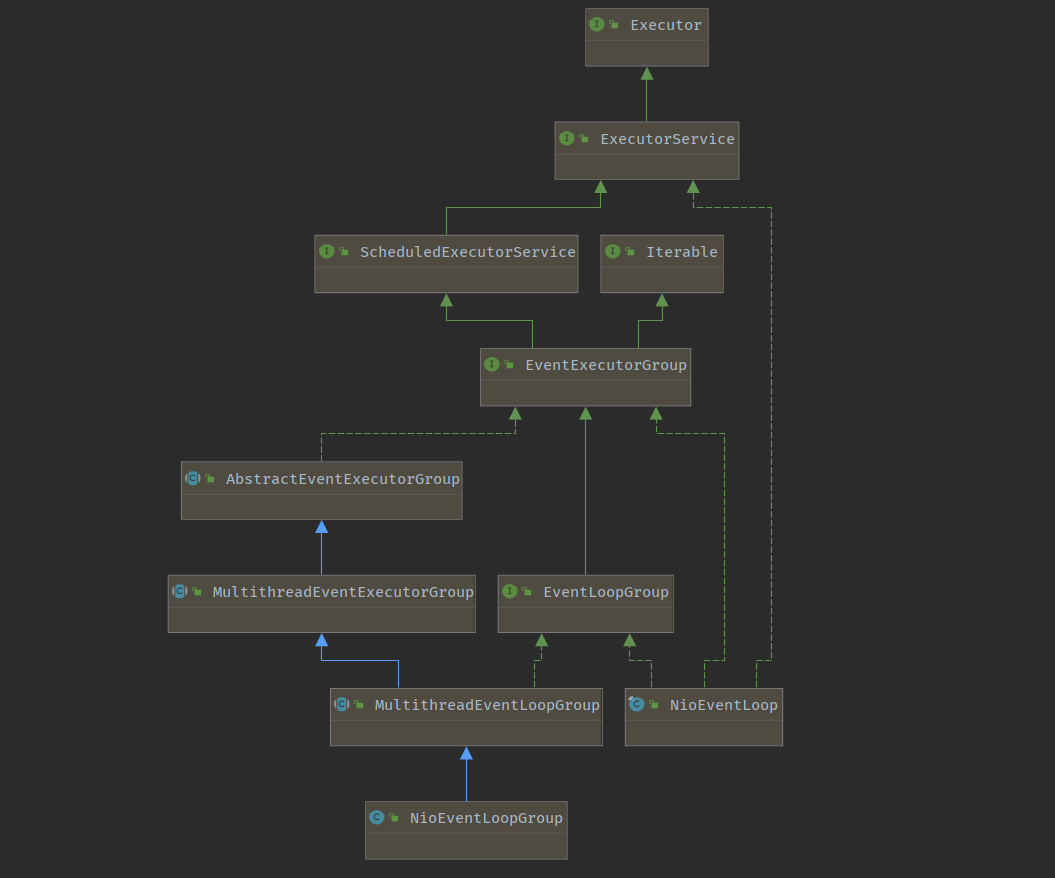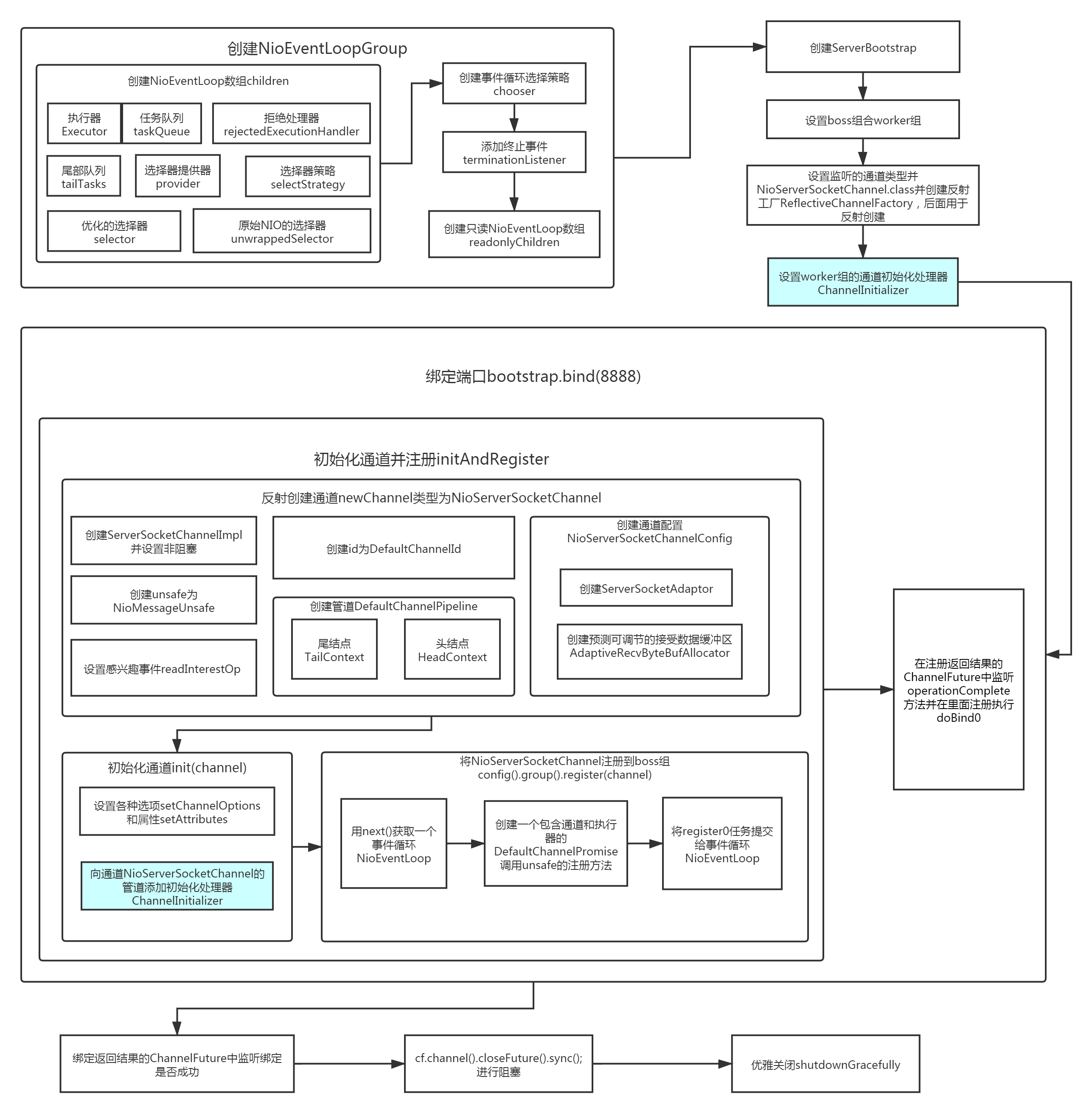主题
NioEventLoop原理分析
1. 概述
在对NioEventLoop原理进行分析之前,先提出三个常见问题:
- 默认情况下,Netty服务端起多少个线程?合适启动的线程?
- Netty是如何解决jdk的空轮训bug的?
- Netty是如何保证异步串行无锁化的?
带着这三个问题,进入下面的NioEventLoop原理分析
2. NioEventLoop是什么
这里可以先简单的将NioEventLoop理解为一个线程,但是NioEventLoop是被封装过的“线程”,这里的不同之处可以埋一个坑进行深入分析。
而NioEventLoop在Netty中起到什么作用呢?读完下文的你应该就会有答案了。
3. NioEventLoop的创建
首先,抛出一个结论,NioEventLoop是在NioEventLoopGroup中创建出来的,具体方法逻辑如下:
NioEventLoopGroup.java
java
@Override
protected EventLoop newChild(Executor executor, Object... args) throws Exception {
return new NioEventLoop(this, executor, (SelectorProvider) args[0],
((SelectStrategyFactory) args[1]).newSelectStrategy(), (RejectedExecutionHandler) args[2]);
}可以看出,在NioEventLoopGroup中的newChild方法入参里,传入了一个Executor对象,这是一个线程池对象,除此之外,还有可变参数args,带入到NioEventLoop的构造 方法里,分别强转为了SelectorProvider、SelectStrategyFactory和RejectedExecutionHandler这三个对象。读到这里可能很多人都会懵,newChild是从哪里调进来的?
为了故事的顺利发展,让我们的目光来到NioEventLoopGroup,查看下其Diagrams图。

可以看到NioEventLoopGroup的顶级父接口是Executor,直白点理解NioEventLoopGroup就是一个线程池,NioEventLoop就是其创建出来的一个线程!下面看到NioEventLoopGroup的构造方法
NioEventLoopGroup.java
java
public NioEventLoopGroup() {
this(0);
}
public NioEventLoopGroup(int nThreads) {
this(nThreads, (Executor) null);
}
public NioEventLoopGroup(int nThreads, ThreadFactory threadFactory) {
this(nThreads, threadFactory, SelectorProvider.provider());
}
public NioEventLoopGroup(int nThreads, Executor executor) {
this(nThreads, executor, SelectorProvider.provider());
}
public NioEventLoopGroup(
int nThreads, ThreadFactory threadFactory, final SelectorProvider selectorProvider) {
this(nThreads, threadFactory, selectorProvider, DefaultSelectStrategyFactory.INSTANCE);
}
public NioEventLoopGroup(int nThreads, ThreadFactory threadFactory,
final SelectorProvider selectorProvider, final SelectStrategyFactory selectStrategyFactory) {
super(nThreads, threadFactory, selectorProvider, selectStrategyFactory, RejectedExecutionHandlers.reject());
}
public NioEventLoopGroup(
int nThreads, Executor executor, final SelectorProvider selectorProvider) {
this(nThreads, executor, selectorProvider, DefaultSelectStrategyFactory.INSTANCE);
}
public NioEventLoopGroup(int nThreads, Executor executor, final SelectorProvider selectorProvider,
final SelectStrategyFactory selectStrategyFactory) {
super(nThreads, executor, selectorProvider, selectStrategyFactory, RejectedExecutionHandlers.reject());
}
public NioEventLoopGroup(int nThreads, Executor executor, EventExecutorChooserFactory chooserFactory,
final SelectorProvider selectorProvider,
final SelectStrategyFactory selectStrategyFactory) {
super(nThreads, executor, chooserFactory, selectorProvider, selectStrategyFactory,
RejectedExecutionHandlers.reject());
}
public NioEventLoopGroup(int nThreads, Executor executor, EventExecutorChooserFactory chooserFactory,
final SelectorProvider selectorProvider,
final SelectStrategyFactory selectStrategyFactory,
final RejectedExecutionHandler rejectedExecutionHandler) {
super(nThreads, executor, chooserFactory, selectorProvider, selectStrategyFactory, rejectedExecutionHandler);
}这么多的构造方法,每个方法传入的入参都不一样,可以看到默认构造方法调用的是
java
public NioEventLoopGroup() {
this(0);
}一路跟到父类MultithreadEventLoopGroup,可以看到如下关键代码:
MultithreadEventLoopGroup
java
private static final int DEFAULT_EVENT_LOOP_THREADS;
static {
DEFAULT_EVENT_LOOP_THREADS = Math.max(1, SystemPropertyUtil.getInt(
"io.netty.eventLoopThreads", Runtime.getRuntime().availableProcessors() * 2));
if (logger.isDebugEnabled()) {
logger.debug("-Dio.netty.eventLoopThreads: {}", DEFAULT_EVENT_LOOP_THREADS);
}
}
protected MultithreadEventLoopGroup(int nThreads, ThreadFactory threadFactory, Object... args) {
super(nThreads == 0 ? DEFAULT_EVENT_LOOP_THREADS : nThreads, threadFactory, args);
}可以得出一个结论就是:当NioEventLoopGroup默认黄金的线程数是 2 * CPU 个。
NioEventLoop的创建核心逻辑在MultithreadEventExecutorGroup构造方法中,可以看到如下逻辑,分析内容待定...
MultithreadEventExecutorGroup.java
java
protected MultithreadEventExecutorGroup(int nThreads, Executor executor,
EventExecutorChooserFactory chooserFactory, Object... args) {
if (nThreads <= 0) {
throw new IllegalArgumentException(String.format("nThreads: %d (expected: > 0)", nThreads));
}
if (executor == null) {
executor = new ThreadPerTaskExecutor(newDefaultThreadFactory());
}
children = new EventExecutor[nThreads];
for (int i = 0; i < nThreads; i ++) {
boolean success = false;
try {
children[i] = newChild(executor, args);
success = true;
} catch (Exception e) {
// TODO: Think about if this is a good exception type
throw new IllegalStateException("failed to create a child event loop", e);
} finally {
if (!success) {
for (int j = 0; j < i; j ++) {
children[j].shutdownGracefully();
}
for (int j = 0; j < i; j ++) {
EventExecutor e = children[j];
try {
while (!e.isTerminated()) {
e.awaitTermination(Integer.MAX_VALUE, TimeUnit.SECONDS);
}
} catch (InterruptedException interrupted) {
// Let the caller handle the interruption.
Thread.currentThread().interrupt();
break;
}
}
}
}
}
chooser = chooserFactory.newChooser(children);
final FutureListener<Object> terminationListener = new FutureListener<Object>() {
@Override
public void operationComplete(Future<Object> future) throws Exception {
if (terminatedChildren.incrementAndGet() == children.length) {
terminationFuture.setSuccess(null);
}
}
};
for (EventExecutor e: children) {
e.terminationFuture().addListener(terminationListener);
}
Set<EventExecutor> childrenSet = new LinkedHashSet<EventExecutor>(children.length);
Collections.addAll(childrenSet, children);
readonlyChildren = Collections.unmodifiableSet(childrenSet);
}
NioEventLoopGroup#newChild()
java
@Override
protected EventLoop newChild(Executor executor, Object... args) throws Exception {
return new NioEventLoop(this, executor, (SelectorProvider) args[0],
((SelectStrategyFactory) args[1]).newSelectStrategy(), (RejectedExecutionHandler) args[2]);
}下面是NioEventLoop类的构造方法
java
NioEventLoop(NioEventLoopGroup parent, Executor executor, SelectorProvider selectorProvider,
SelectStrategy strategy, RejectedExecutionHandler rejectedExecutionHandler) {
super(parent, executor, false, DEFAULT_MAX_PENDING_TASKS, rejectedExecutionHandler);
if (selectorProvider == null) {
throw new NullPointerException("selectorProvider");
}
if (strategy == null) {
throw new NullPointerException("selectStrategy");
}
provider = selectorProvider;
// 此处可以看出,每个NioEventLoop都会和一个Selector绑定对应
selector = openSelector();
selectStrategy = strategy;
}每个NioEventLoop都会和一个Selector进行绑定对应。
SingleThreadEventLoop.java构造方法中
java
protected SingleThreadEventLoop(EventLoopGroup parent, Executor executor,
boolean addTaskWakesUp, int maxPendingTasks,
RejectedExecutionHandler rejectedExecutionHandler) {
super(parent, executor, addTaskWakesUp, maxPendingTasks, rejectedExecutionHandler);
tailTasks = newTaskQueue(maxPendingTasks);
}NioEventLoop.java
java
@Override
protected Queue<Runnable> newTaskQueue(int maxPendingTasks) {
// This event loop never calls takeTask()
return PlatformDependent.newMpscQueue(maxPendingTasks);
}这里的任务队列有啥用?
我们都知道,在Netty中是多线程的,即多个NioEventLoop,任务队列的作用就是当其他NioEventLoop拿到CPU的执行权时,却得到了其他线程的IO请求,此时NioEventLoop就把当前这个未处理完的请求 以任务的形式提交到对应NioEventLoop的队列中进行串行执行,能够保证线程安全。
EventExecutorChooser是什么?有什么作用?
在MultithreadEventExecutorGroup.java构造方法中,对EventExecutorChooser进行了赋值
java
chooser = chooserFactory.newChooser(children);DefaultEventExecutorChooserFactory#newChooser
java
public EventExecutorChooser newChooser(EventExecutor[] executors) {
// 判断executors的数量是否是2次幂,2、4、8、16
if (isPowerOfTwo(executors.length)) {
// 调用优化过的EventExecutorChooser
return new PowerOfTowEventExecutorChooser(executors);
} else {
return new GenericEventExecutorChooser(executors);
}
}先看下未优化过的ExecutorChooser,原理就是对executors.length 进行取模,这样就可以对Executors的索引位进行循环使用。
java
private static final class GenericEventExecutorChooser implements EventExecutorChooser {
private final AtomicInteger idx = new AtomicInteger();
private final EventExecutor[] executors;
GenericEventExecutorChooser(EventExecutor[] executors) {
this.executors = executors;
}
@Override
public EventExecutor next() {
return executors[Math.abs(idx.getAndIncrement() % executors.length)];
}
}优化过的ExecutorChooser,原理是通过&对executors进行取模操作。
java
private static final class PowerOfTowEventExecutorChooser implements EventExecutorChooser {
private final AtomicInteger idx = new AtomicInteger();
private final EventExecutor[] executors;
PowerOfTowEventExecutorChooser(EventExecutor[] executors) {
this.executors = executors;
}
@Override
public EventExecutor next() {
return executors[idx.getAndIncrement() & executors.length - 1];
}
}&取模原理如下图: 
idx是当前索引位置,而加入executors数量为16,则16-1=15,二进制为
1111idx二进制如下:
111010由于是&操作,则相当于只取后四位,则idx & (Executors.length - 1) = 1010
如果此时idx为:1111,而此时进行&操作过后,结果就是:1111,
则idx索引位再+1,则结果就是0000,这样就达到了循环使用索引位的效果。
4. NioEventLoop的启动
先把关键步骤码出来,后面再过来分析。
AbstractBootstrap#doBind()
java
private ChannelFuture doBind(final SocketAddress localAddress) {
// 初始化并注册通道Channel
final ChannelFuture regFuture = initAndRegister();
final Channel channel = regFuture.channel();
if (regFuture.cause() != null) {
return regFuture;
}
// channelFuture完成了
if (regFuture.isDone()) {
ChannelPromise promise = channel.newPromise();
// 进入NioEventLoop的初始化
doBind0(regFuture, channel, localAddress, promise);
return promise;
} else {
// Registration future is almost always fulfilled already, but just in case it's not.
final PendingRegistrationPromise promise = new PendingRegistrationPromise(channel);
regFuture.addListener(new ChannelFutureListener() {
@Override
public void operationComplete(ChannelFuture future) throws Exception {
Throwable cause = future.cause();
if (cause != null) {
// Registration on the EventLoop failed so fail the ChannelPromise directly to not cause an
// IllegalStateException once we try to access the EventLoop of the Channel.
promise.setFailure(cause);
} else {
// Registration was successful, so set the correct executor to use.
// See https://github.com/netty/netty/issues/2586
promise.registered();
doBind0(regFuture, channel, localAddress, promise);
}
}
});
return promise;
}
}AbstractBootstrap.java
java
private static void doBind0(
final ChannelFuture regFuture, final Channel channel,
final SocketAddress localAddress, final ChannelPromise promise) {
channel.eventLoop().execute(new Runnable() {
@Override
public void run() {
if (regFuture.isSuccess()) {
channel.bind(localAddress, promise).addListener(ChannelFutureListener.CLOSE_ON_FAILURE);
} else {
promise.setFailure(regFuture.cause());
}
}
});
}SingleThreadEventExecutor#execute
java
@Override
public void execute(Runnable task) {
if (task == null) {
throw new NullPointerException("task");
}
boolean inEventLoop = inEventLoop();
addTask(task);
if (!inEventLoop) {
startThread();
if (isShutdown()) {
boolean reject = false;
try {
if (removeTask(task)) {
reject = true;
}
} catch (UnsupportedOperationException e) {
// The task queue does not support removal so the best thing we can do is to just move on and
// hope we will be able to pick-up the task before its completely terminated.
// In worst case we will log on termination.
}
if (reject) {
reject();
}
}
}
if (!addTaskWakesUp && wakesUpForTask(task)) {
wakeup(inEventLoop);
}
}
private void startThread() {
if (state == ST_NOT_STARTED) {
if (STATE_UPDATER.compareAndSet(this, ST_NOT_STARTED, ST_STARTED)) {
boolean success = false;
try {
doStartThread();
success = true;
} finally {
if (!success) {
STATE_UPDATER.compareAndSet(this, ST_STARTED, ST_NOT_STARTED);
}
}
}
}
}
private void doStartThread() {
assert thread == null;
executor.execute(new Runnable() {
@Override
public void run() {
thread = Thread.currentThread();
if (interrupted) {
thread.interrupt();
}
boolean success = false;
updateLastExecutionTime();
try {
SingleThreadEventExecutor.this.run();
success = true;
} catch (Throwable t) {
logger.warn("Unexpected exception from an event executor: ", t);
} finally {
for (;;) {
int oldState = state;
if (oldState >= ST_SHUTTING_DOWN || STATE_UPDATER.compareAndSet(
SingleThreadEventExecutor.this, oldState, ST_SHUTTING_DOWN)) {
break;
}
}
// Check if confirmShutdown() was called at the end of the loop.
if (success && gracefulShutdownStartTime == 0) {
if (logger.isErrorEnabled()) {
logger.error("Buggy " + EventExecutor.class.getSimpleName() + " implementation; " +
SingleThreadEventExecutor.class.getSimpleName() + ".confirmShutdown() must " +
"be called before run() implementation terminates.");
}
}
try {
// Run all remaining tasks and shutdown hooks.
for (;;) {
if (confirmShutdown()) {
break;
}
}
} finally {
try {
cleanup();
} finally {
// Lets remove all FastThreadLocals for the Thread as we are about to terminate and notify
// the future. The user may block on the future and once it unblocks the JVM may terminate
// and start unloading classes.
// See https://github.com/netty/netty/issues/6596.
FastThreadLocal.removeAll();
STATE_UPDATER.set(SingleThreadEventExecutor.this, ST_TERMINATED);
threadLock.countDown();
if (logger.isWarnEnabled() && !taskQueue.isEmpty()) {
logger.warn("An event executor terminated with " +
"non-empty task queue (" + taskQueue.size() + ')');
}
terminationFuture.setSuccess(null);
}
}
}
}
});
}就这样,调用了NioEventLoop的run方法,进行了NioEventLoop启动 NioEventLoop#run
java
@Override
protected void run() {
for (;;) {
try {
try {
switch (selectStrategy.calculateStrategy(selectNowSupplier, hasTasks())) {
case SelectStrategy.CONTINUE:
continue;
case SelectStrategy.BUSY_WAIT:
// fall-through to SELECT since the busy-wait is not supported with NIO
case SelectStrategy.SELECT:
select(wakenUp.getAndSet(false));
// 'wakenUp.compareAndSet(false, true)' is always evaluated
// before calling 'selector.wakeup()' to reduce the wake-up
// overhead. (Selector.wakeup() is an expensive operation.)
//
// However, there is a race condition in this approach.
// The race condition is triggered when 'wakenUp' is set to
// true too early.
//
// 'wakenUp' is set to true too early if:
// 1) Selector is waken up between 'wakenUp.set(false)' and
// 'selector.select(...)'. (BAD)
// 2) Selector is waken up between 'selector.select(...)' and
// 'if (wakenUp.get()) { ... }'. (OK)
//
// In the first case, 'wakenUp' is set to true and the
// following 'selector.select(...)' will wake up immediately.
// Until 'wakenUp' is set to false again in the next round,
// 'wakenUp.compareAndSet(false, true)' will fail, and therefore
// any attempt to wake up the Selector will fail, too, causing
// the following 'selector.select(...)' call to block
// unnecessarily.
//
// To fix this problem, we wake up the selector again if wakenUp
// is true immediately after selector.select(...).
// It is inefficient in that it wakes up the selector for both
// the first case (BAD - wake-up required) and the second case
// (OK - no wake-up required).
if (wakenUp.get()) {
selector.wakeup();
}
// fall through
default:
}
} catch (IOException e) {
// If we receive an IOException here its because the Selector is messed up. Let's rebuild
// the selector and retry. https://github.com/netty/netty/issues/8566
rebuildSelector0();
handleLoopException(e);
continue;
}
cancelledKeys = 0;
needsToSelectAgain = false;
final int ioRatio = this.ioRatio;
if (ioRatio == 100) {
try {
processSelectedKeys();
} finally {
// Ensure we always run tasks.
runAllTasks();
}
} else {
final long ioStartTime = System.nanoTime();
try {
processSelectedKeys();
} finally {
// Ensure we always run tasks.
final long ioTime = System.nanoTime() - ioStartTime;
runAllTasks(ioTime * (100 - ioRatio) / ioRatio);
}
}
} catch (Throwable t) {
handleLoopException(t);
}
// Always handle shutdown even if the loop processing threw an exception.
try {
if (isShuttingDown()) {
closeAll();
if (confirmShutdown()) {
return;
}
}
} catch (Throwable t) {
handleLoopException(t);
}
}
}5. NioEventLoop执行逻辑

